Formal gardens represent the pinnacle of structured landscape design, where symmetry, geometry, and classical principles create timeless outdoor carefully orchestrated environments blend architectural elements with nature's beauty, resulting in sophisticated gardens that exude elegance and French parterre gardens to Italian Renaissance courtyards, formal garden design emphasizes balance, proportion, and meticulous element serves a purpose within the greater composition, creating harmonious outdoor rooms that function as extensions of refined living featuring manicured hedges, geometric pathways, or classical water features, formal gardens offer endless inspiration for creating distinguished outdoor environments.

1. French Parterre Garden with Boxwood Hedges
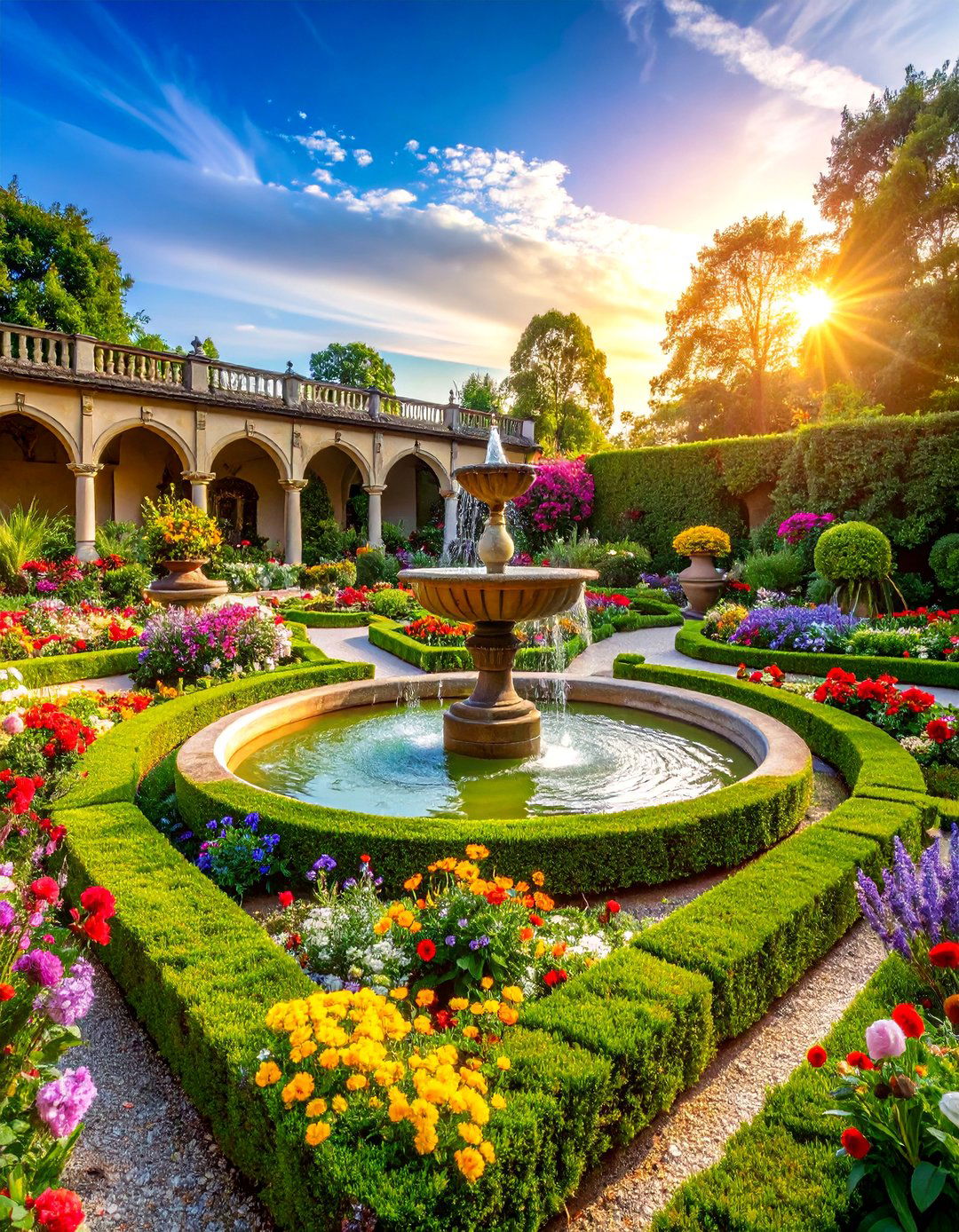
This quintessential formal garden style features intricate patterns created by low boxwood hedges forming elaborate geometric parterre layout includes carefully maintained gravel pathways that weave between the hedged compartments, each filled with seasonal flowers or colored focal points such as ornate urns or small fountains anchor the design, while symmetrical placement of topiary specimens adds vertical surrounding framework consists of taller hedges or stone balustrades that define the garden's classic French approach emphasizes precision and artistry, creating a living tapestry that changes subtly with the seasons while maintaining its structured elegance year-round.
2. Italian Renaissance Garden with Marble Statuary

Drawing inspiration from grand Italian villas, this formal garden combines classical architecture with structured levels connected by elegant stone staircases create dramatic elevation changes, while marble statues and carved fountains serve as commanding focal points. Box-lined parterres filled with aromatic herbs and flowering plants provide textural contrast to the stone trees planted in formal rows create natural columns that frame views and provide vertical features, including tiered fountains and narrow rills, add movement and sound throughout the overall design emphasizes grandeur and classical proportions, creating an outdoor museum that celebrates both horticultural and artistic excellence.
3. English Tudor Garden with Clipped Yew Hedges
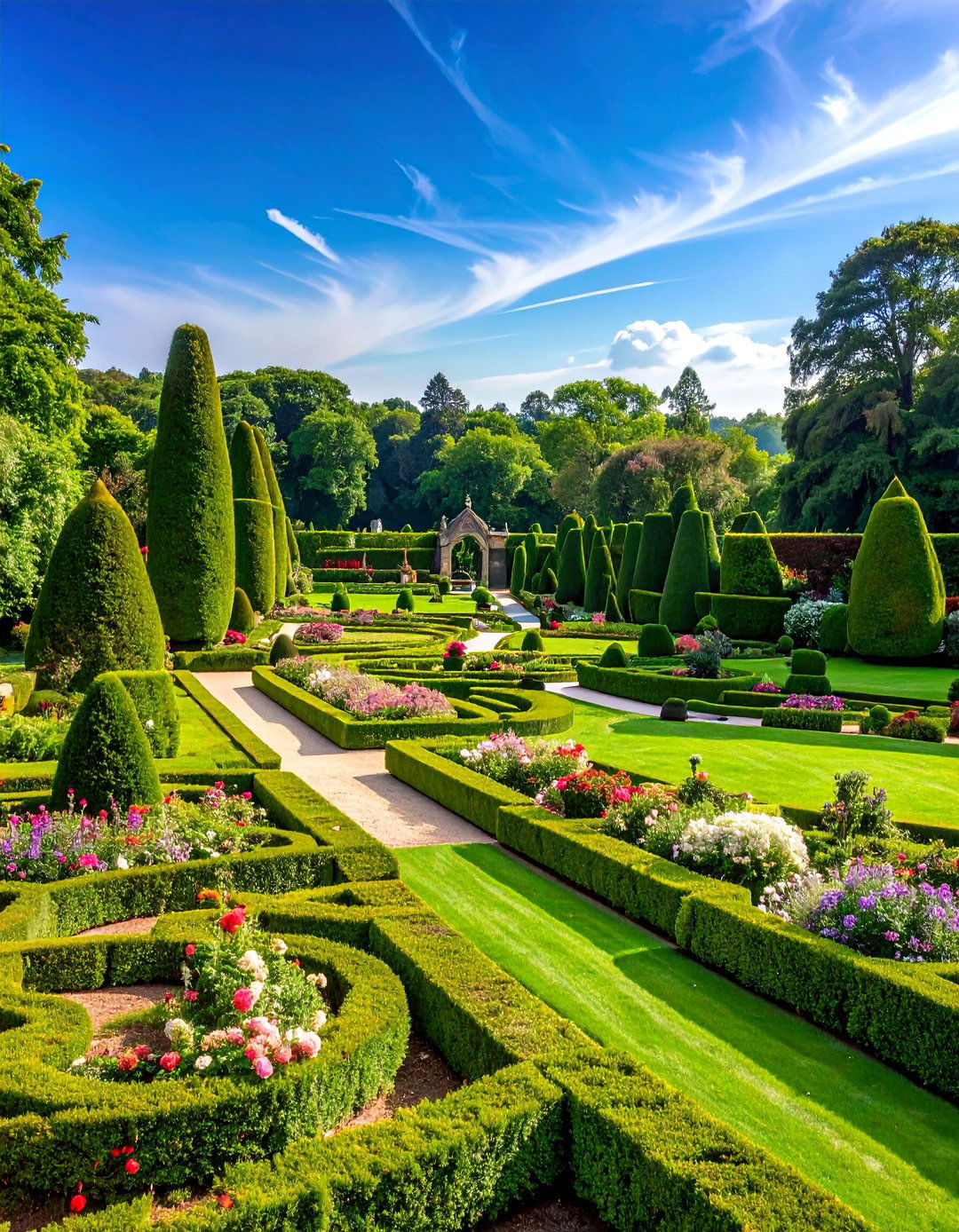
This historically inspired formal garden recreates the enclosed intimacy of Tudor manor houses through the use of tall yew hedges that form garden compartment serves a specific purpose, from herb gardens to rose collections, connected by grass pathways and brick-edged elements include sundials, weathered stone benches, and wrought iron gates that provide glimpses between garden hornbeam or lime trees create living screens above head height, while knot gardens featuring lavender and santolina add intricate ground-level color palette remains deliberately restrained, focusing on various shades of green punctuated by seasonal blooms in white, purple, and deep red tones.
4. Geometric Rose Garden with Gravel Pathways
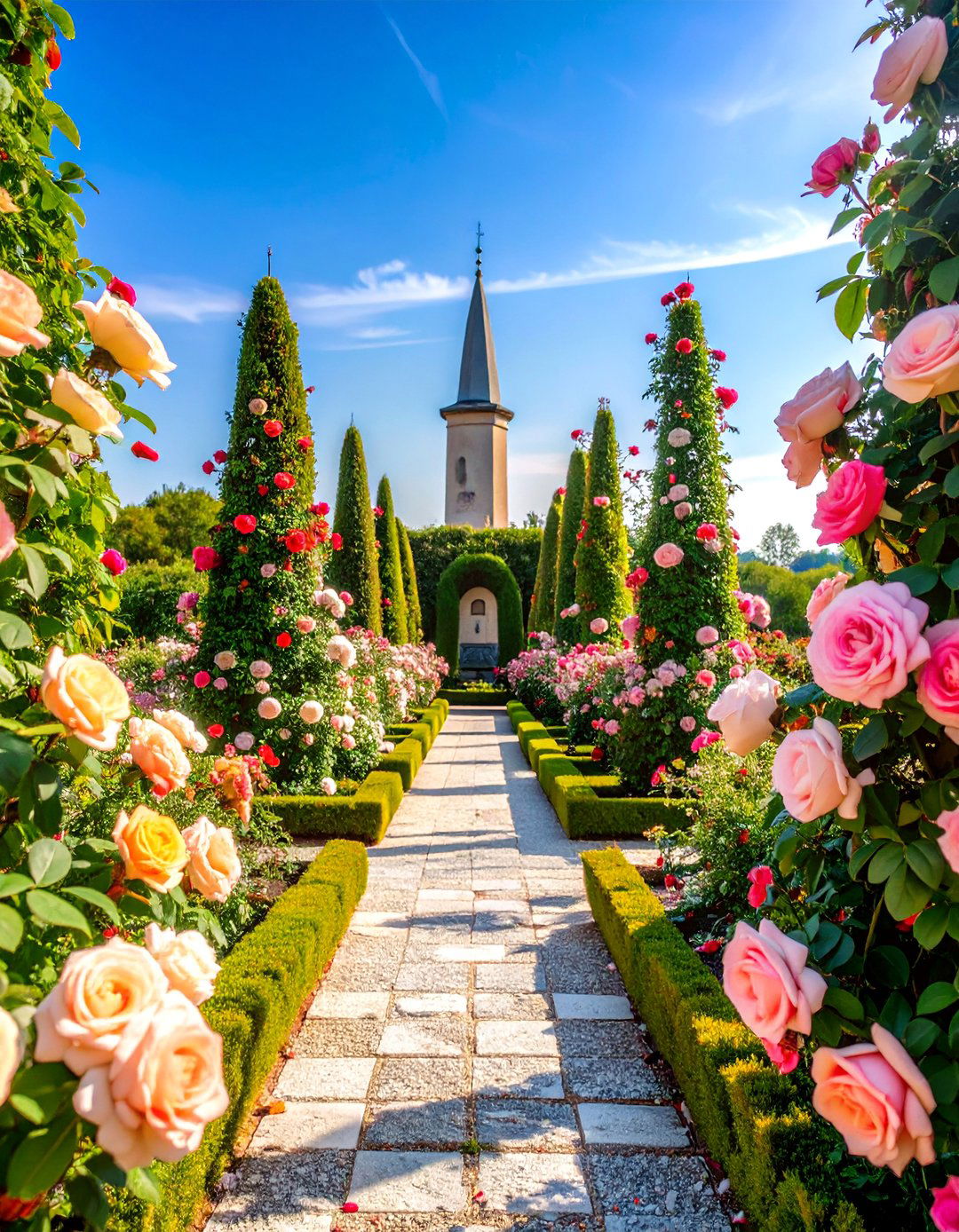
A sophisticated interpretation of the classic rose garden, this design organizes plantings within precise geometric shapes bordered by neatly raked gravel tea roses and David Austin varieties are arranged in formal beds edged with low stone or metal borders, creating clean lines that emphasize the garden 's intersections feature decorative elements such as armillary spheres or rose-covered obelisks that provide vertical gravel pathways, typically crushed limestone or pea gravel, create a neutral backdrop that highlights the roses' colors while ensuring excellent companion plantings of lavender, catmint, or boxwood provide structure during winter months when roses are dormant.
5. Classical Courtyard Garden with Central Fountain
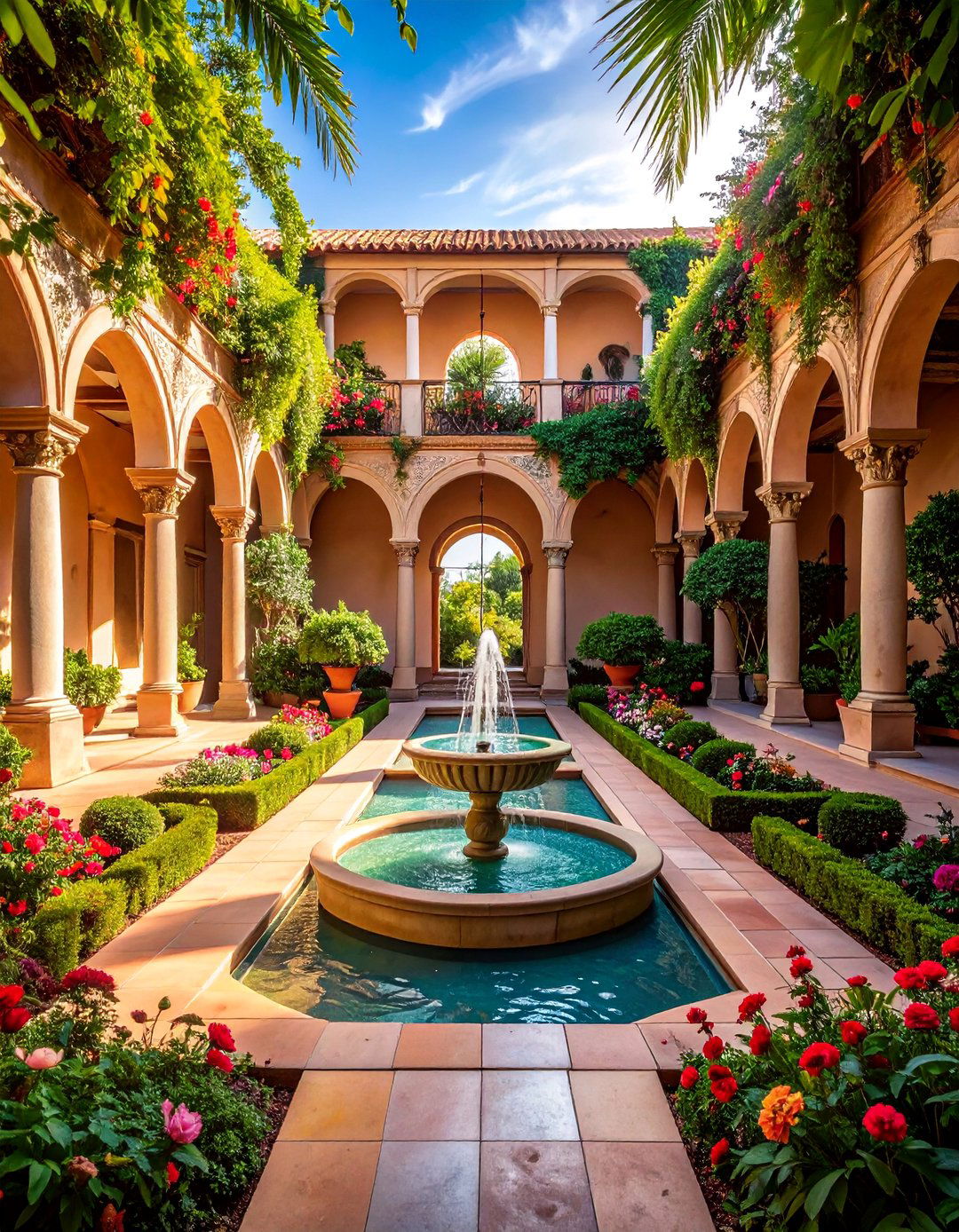
Designed as an enclosed outdoor room, this formal garden centers around an elegant fountain surrounded by symmetrical plantings and quadrants radiate from the central water feature, each containing identical plantings of evergreen shrubs, seasonal flowers, and ornamental grasses arranged in geometric patterns. Portico-style architecture or pergolas create covered walkways around the garden 's perimeter, while classical columns or pilasters add architectural include natural stone paving, wrought iron furniture, and carved stone planters that reinforce the formal fountain serves both as a focal point and a source of soothing water sounds that enhance the garden' s contemplative atmosphere.
6. Topiary Garden with Spiral and Cone Shapes

This sculptural approach to formal gardening showcases the art of topiary through carefully shaped evergreen specimens arranged in geometric patterns. Yew, boxwood, and privet are crafted into spirals, cones, spheres, and architectural forms that create a living sculpture topiary specimens are positioned along formal axes and sight lines, with complementary plantings of flowering perennials providing seasonal color or grass pathways connect the various topiary groupings, while strategic placement of benches allows visitors to appreciate the craftsmanship from multiple vantage maintenance ensures sharp, clean lines that emphasize the artistry involved in this ancient gardening result is a garden that functions as outdoor architecture.
7. Formal Herb Garden with Stone Borders

This practical yet elegant garden design organizes culinary and medicinal herbs within a structured framework of stone-edged beds arranged in geometric patterns. A central pathway, often constructed from flagstone or brick, provides the main axis from which symmetrical planting areas bed contains specific herb varieties grouped by use or characteristics, with taller specimens like rosemary and sage providing structure while lower plants like thyme and oregano create textural elements include sundials, bee skeps, or carved stone markers that identify different herb design balances functionality with beauty, ensuring easy access for harvesting while maintaining the visual appeal essential to formal garden design.
8. Victorian Garden with Cast Iron Features

Reflecting the ornate sensibilities of the Victorian era, this formal garden combines elaborate cast iron elements with structured plantings arranged in complex geometric gazebos, decorative urns, and intricate garden furniture create focal points throughout the space, while wrought iron edging defines planting beds with plant palette emphasizes bold foliage and vibrant flowering displays, including tropical specimens, colorful annuals, and sculptural plants arranged in carpet bedding paths wind between the various garden compartments, connecting seating areas and style celebrates abundance and craftsmanship, creating a garden that serves as both a display of horticultural skill and a testament to period design sensibilities.
9. Mediterranean Terrace Garden with Citrus Trees
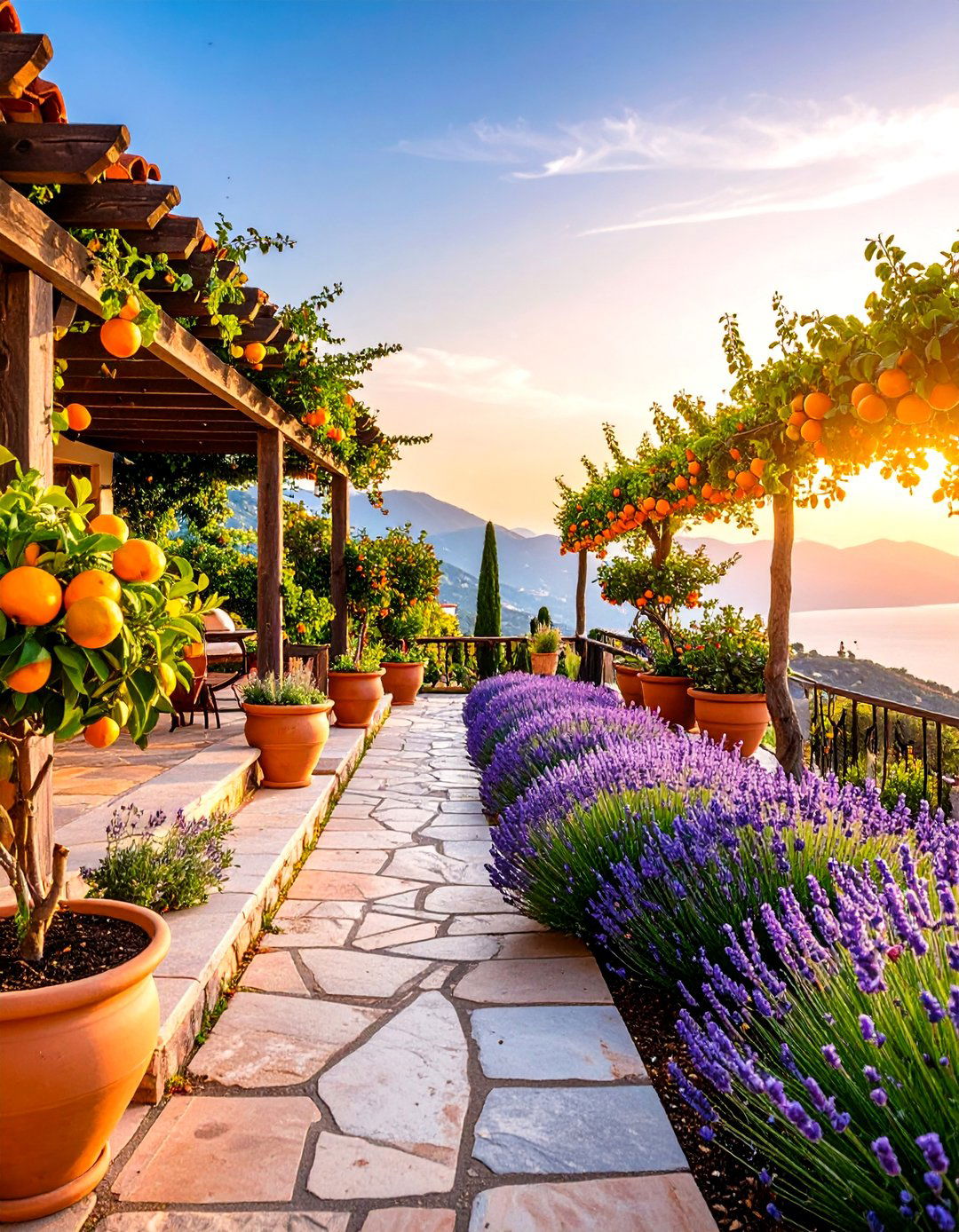
Inspired by hillside gardens of Southern Europe, this formal design creates multiple levels connected by stone staircases and retaining terrace contains geometric planting beds bordered by clipped lavender or rosemary hedges, while potted citrus trees in decorative containers provide focal points and practical materials include terra cotta, natural stone, and wrought iron, creating an authentic Mediterranean features such as wall fountains or small pools add cooling elements, while pergolas draped with grapevines provide shaded seating plant palette emphasizes drought-tolerant species with gray-green foliage and aromatic qualities, creating a garden that appeals to multiple senses while maintaining formal structure through its architectural framework.
10. Colonial Garden with Brick Walkways

This historically accurate garden design recreates the formal layouts common to American colonial estates, featuring geometric beds bordered by brick edging and connected by herringbone brick elements include white-painted picket fences, weathered wooden gates, and simple but elegant garden structures such as arbors or tool plant selection emphasizes heirloom varieties of vegetables, herbs, and flowers that would have been common in colonial times, arranged in neat rows or formal features might include a wellhead, sundial, or simple stone bench positioned to provide views over the entire style balances historical authenticity with practical gardening needs, creating a space that honors traditional American garden design.
11. Japanese Zen Garden with Raked Gravel

A contemplative formal garden design that emphasizes simplicity, balance, and meditation through carefully arranged gravel or sand creates flowing patterns around strategically placed rocks, each representing natural landscapes in miniature. Moss-covered areas and precisely pruned evergreen shrubs provide organic contrast to the mineral elements, while bamboo fencing or wooden screens define the garden 's boundaries. A simple stone lantern, water basin, or meditation platform serves as the focal point, encouraging quiet maintenance ritual of raking the gravel becomes part of the garden' s spiritual practice, creating fresh patterns that symbolize the temporary nature of all garden style prioritizes meaning and symbolism over decorative abundance.
12. Persian Paradise Garden with Water Channels
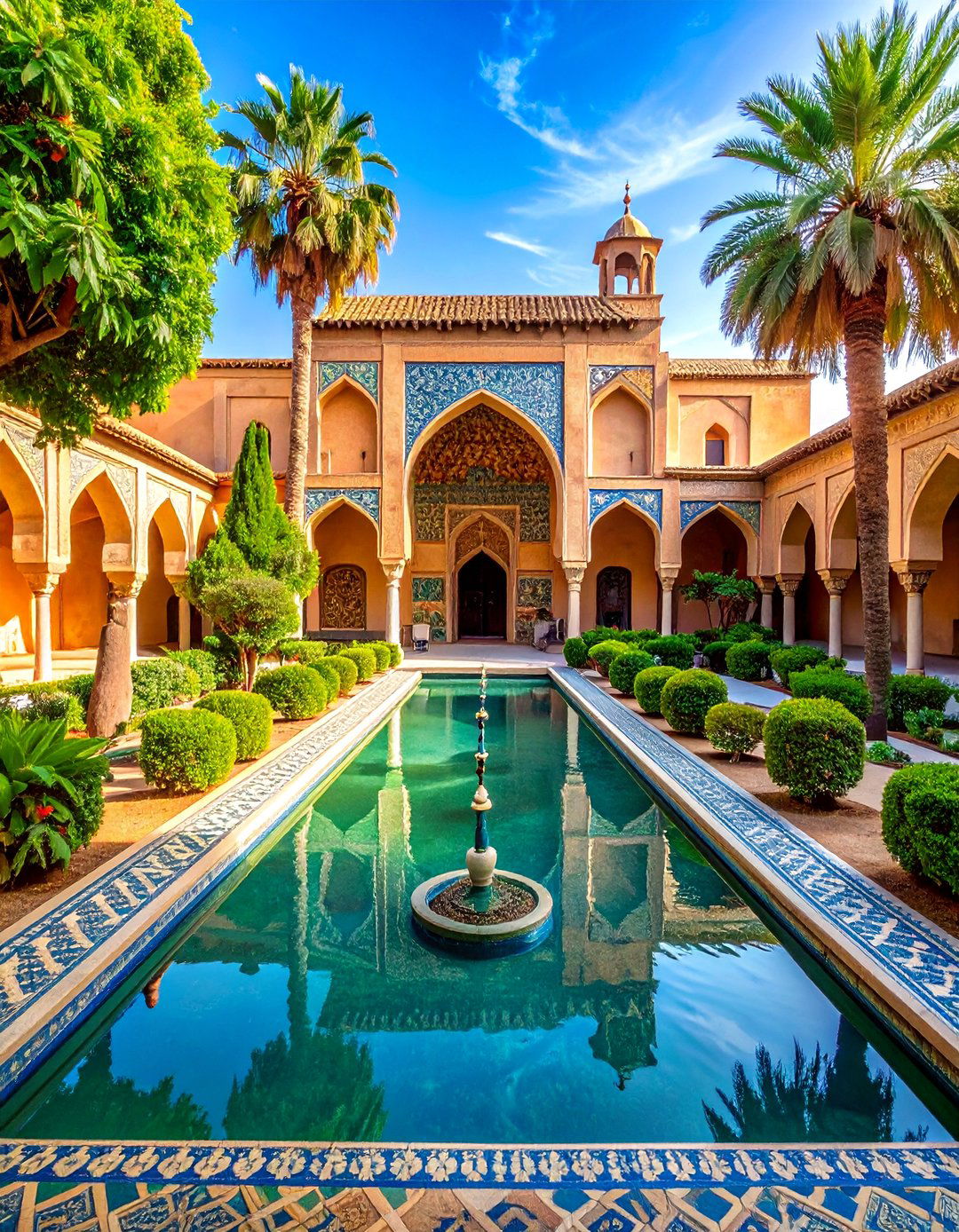
Based on ancient Persian garden design principles, this formal layout creates a representation of paradise through the use of intersecting water channels that divide the space into four equal quadrants. A central pavilion or fountain anchors the design, while straight water rills bordered by stone or tile create cooling pathways throughout the quadrant contains different plantings – fruit trees, flowers, herbs, and vegetables – arranged in geometric patterns that provide both beauty and elements include decorative tiles, carved stone work, and covered seating areas that provide shade and contemplation sound and movement of flowing water creates a sensory experience that transforms the garden into a peaceful retreat from the outside world.
13. Monastery Garden with Cruciform Layout
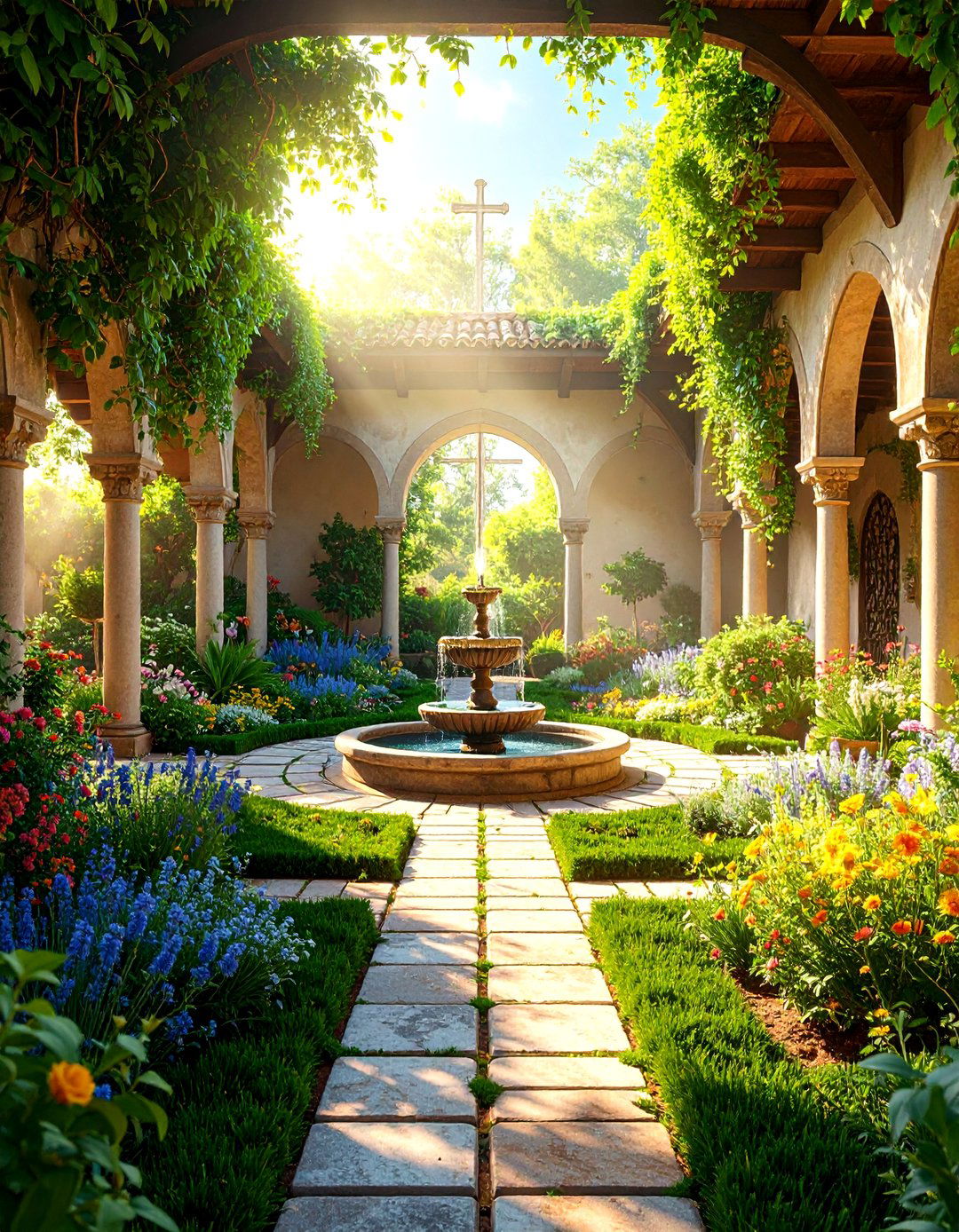
Drawing inspiration from medieval monastic traditions, this formal garden design arranges plantings in a cross-shaped pattern that reflects spiritual central intersection often features a fountain, well, or chapel-like structure, while the four arms contain different types of plants: medicinal herbs, vegetables, flowers for altar decoration, and fruit walkways or cloisters surround the garden, providing sheltered paths for contemplation and connecting to adjacent emphasize simplicity and permanence – stone, weathered wood, and natural plantings that require minimal garden style balances practical needs with spiritual reflection, creating a space that nourishes both body and soul through its harmonious integration of function and meaning.
14. Formal Vegetable Garden with Raised Beds

This elegant interpretation of kitchen garden design elevates vegetable cultivation through geometric raised beds bordered by stone, brick, or beds are arranged in symmetrical patterns around central pathways, often featuring a greenhouse, potting shed, or decorative arbor as a focal are planted in neat rows or geometric patterns, with succession planting ensuring continuous harvests and visual interest throughout the growing elements include trellises for climbing plants, decorative plant labels, and strategically placed benches for garden design proves that functional gardens can be beautiful, combining the satisfaction of home-grown food production with the visual appeal necessary for formal garden changes provide constant variety within the structured framework.
15. Neoclassical Garden with Temple Features
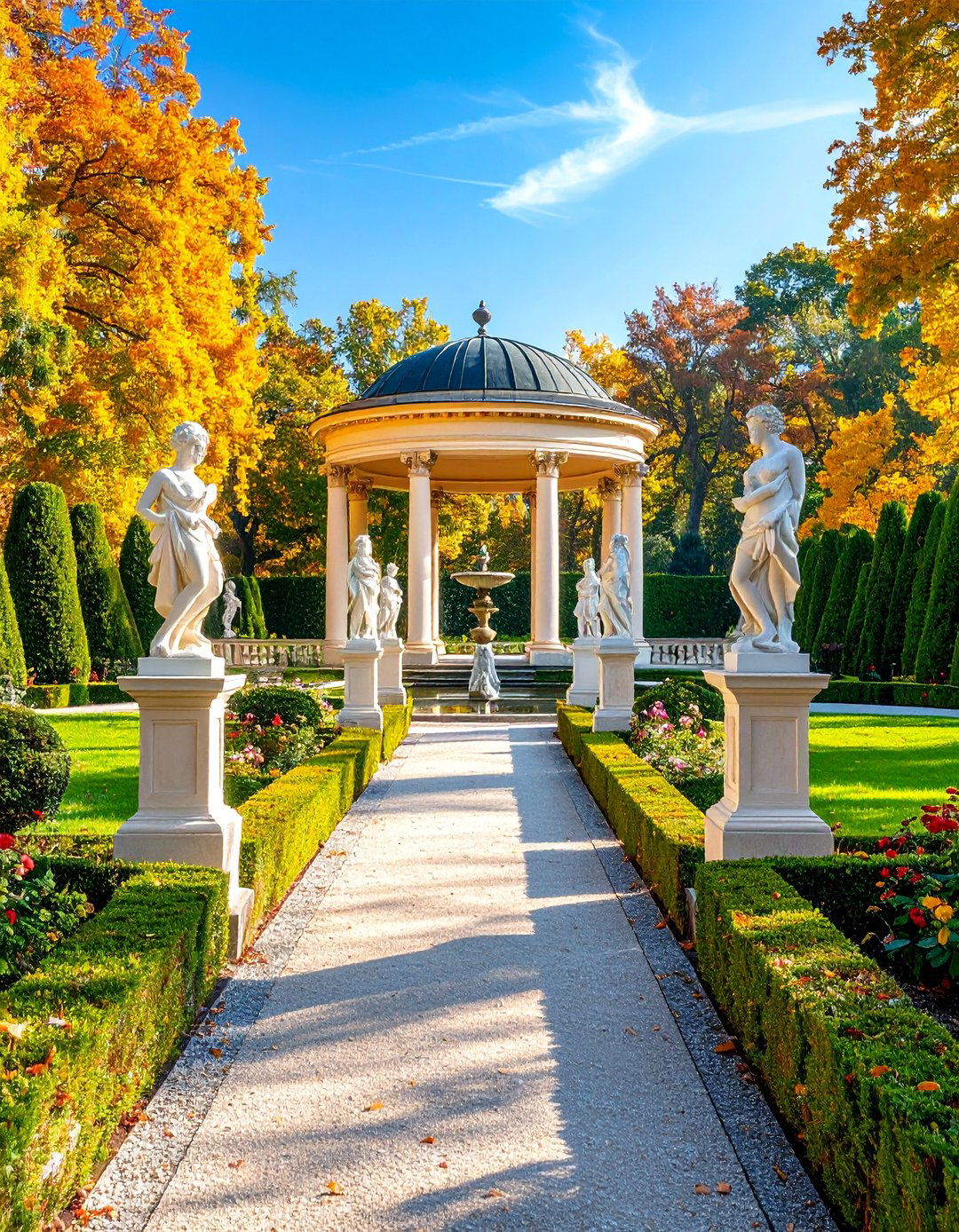
This grand formal garden design incorporates classical architectural elements such as temples, colonnades, or pavilions as focal points within a symmetrical landscape allées lined with trees lead to and from these architectural features, creating dramatic sight lines and processional routes through the plantings emphasize evergreen structure and seasonal displays arranged in geometric patterns, while classical statuary and urns provide additional focal include natural stone, marble, and cast stone that harmonize with the architectural features such as reflecting pools or formal fountains enhance the classical atmosphere, while carefully maintained lawns provide open spaces that showcase the garden's style creates gardens that function as outdoor museums celebrating classical culture and design.
16. Art Deco Garden with Geometric Patterns

Inspired by 1920s and 1930s design aesthetics, this formal garden combines bold geometric patterns with streamlined plantings and decorative planting beds create zigzag or stepped patterns, while plant selections emphasize architectural forms and metallic or silver foliage that reflects the Art Deco materials include polished stone, concrete, and metal elements with distinctive period details such as sunburst patterns or stylized nature fixtures, furniture, and decorative elements feature the characteristic angular forms and luxurious materials associated with this design overall effect creates a garden that captures the optimism and sophistication of the Art Deco era while maintaining the structural principles essential to formal garden design.
17. Contemporary Minimalist Garden with Steel Edging
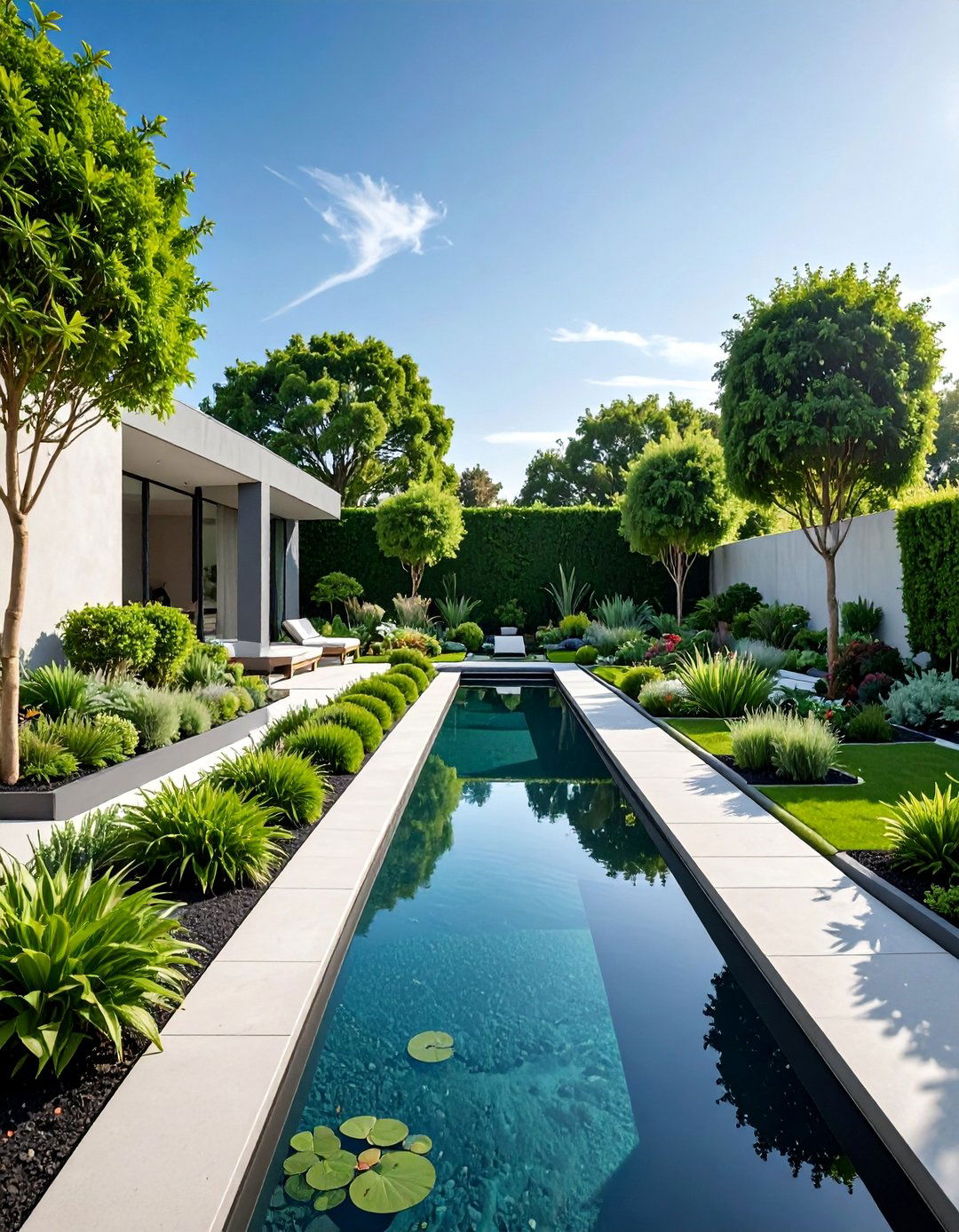
This modern interpretation of formal garden design emphasizes clean lines, limited plant palettes, and high-quality materials to create sophisticated outdoor planting beds are defined by cor-ten steel or stainless steel edging that creates precise borders, while the plant selection focuses on architectural species with strong form and materials include concrete, natural stone, and metal, arranged in simple geometric patterns that emphasize proportion and features, when included, feature linear designs and contemporary materials that complement the overall color palette remains deliberately restrained, focusing on greens, grays, and earth tones punctuated by carefully chosen seasonal garden style proves that formal design principles adapt beautifully to contemporary lifestyles and materials.
18. Knot Garden with Intricate Hedge Patterns
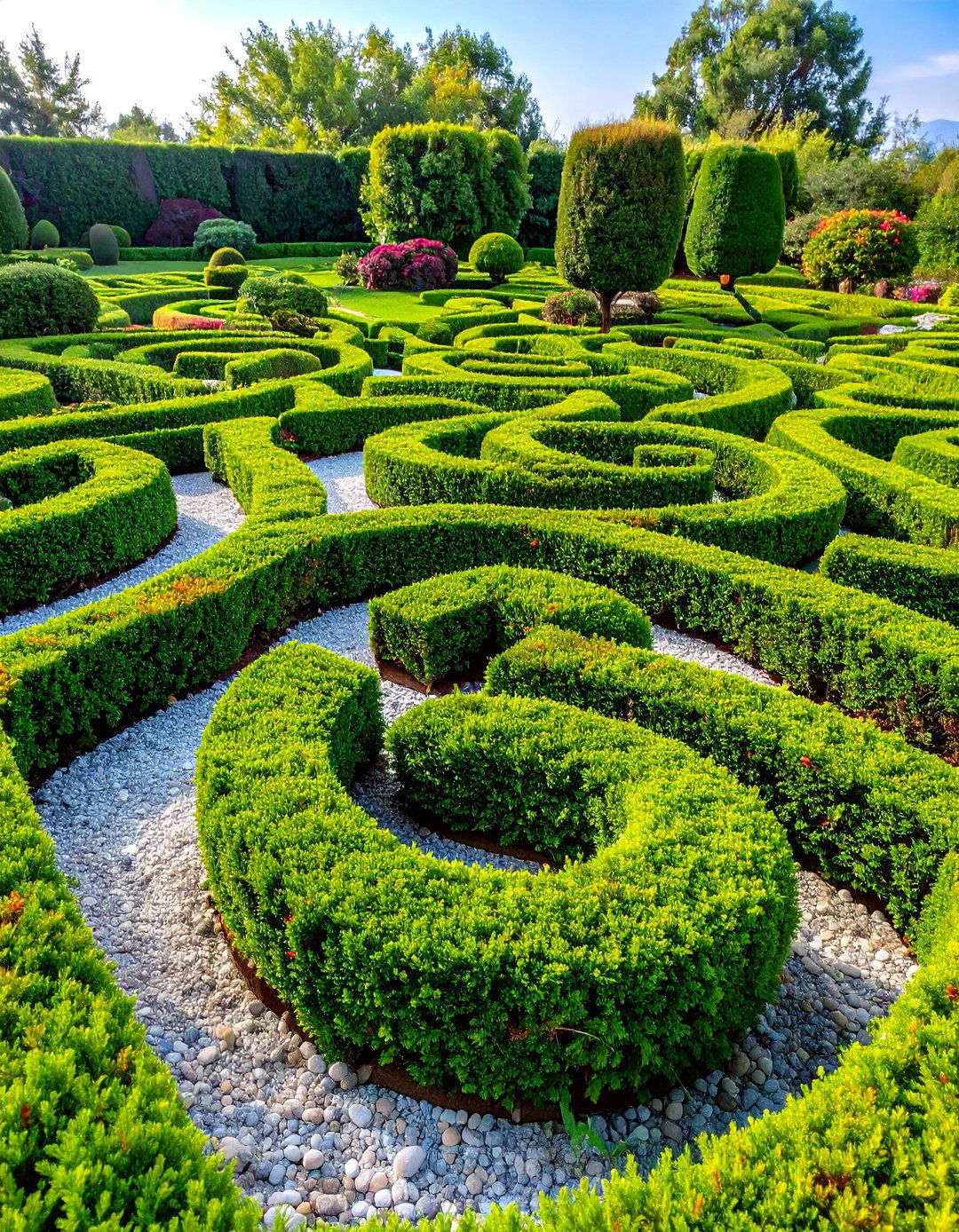
This traditional formal garden design creates complex interwoven patterns using different varieties of low-growing, small-leaved plants that can be maintained at precise heights. Boxwood, santolina, lavender, and germander are arranged in overlapping ribbons that create the illusion of an actual knot when viewed from spaces between the hedge patterns are typically filled with colored gravels, seasonal flowers, or decorative mulches that enhance the contrast and visibility of the viewing points such as raised terraces or upper-story windows allow appreciation of the intricate patterns, while ground-level paths provide access for garden style requires significant skill and patience to establish and maintain, but creates one of the most impressive displays of horticultural craftsmanship possible in garden design.
19. Sunken Garden with Stone Retaining Walls

This dramatic formal garden design creates an enclosed outdoor room by excavating the planting area below the surrounding grade or brick retaining walls provide structural support while creating architectural interest through their materials and construction lead down into the garden space, which typically features symmetrical plantings arranged around a central focal point such as a fountain, sculpture, or specimen enclosed nature of the design creates a microclimate that can support plants that might struggle in more exposed locations, while the walls provide wind protection and thermal areas built into the retaining walls offer intimate viewing points, while the sunken design creates privacy and seclusion from surrounding areas.
20. Formal Cutting Garden with Structured Rows

This practical formal garden design organizes flowers for cutting into neat, geometric rows that provide both beauty and utility. Long, straight beds bordered by paths allow easy access for maintenance and harvesting, while the systematic arrangement of plantings creates visual appeal even in a working garden plant selection emphasizes species with good vase life and seasonal succession, ensuring continuous blooms for indoor structures such as tuteurs, obelisks, and horizontal wire systems are integrated into the design as both functional and decorative elements. A central potting shed or work area provides storage for tools and supplies, while nearby water sources facilitate garden garden style demonstrates that working gardens can maintain formal design principles while serving practical purposes.
21. Palace Garden with Grand Allées
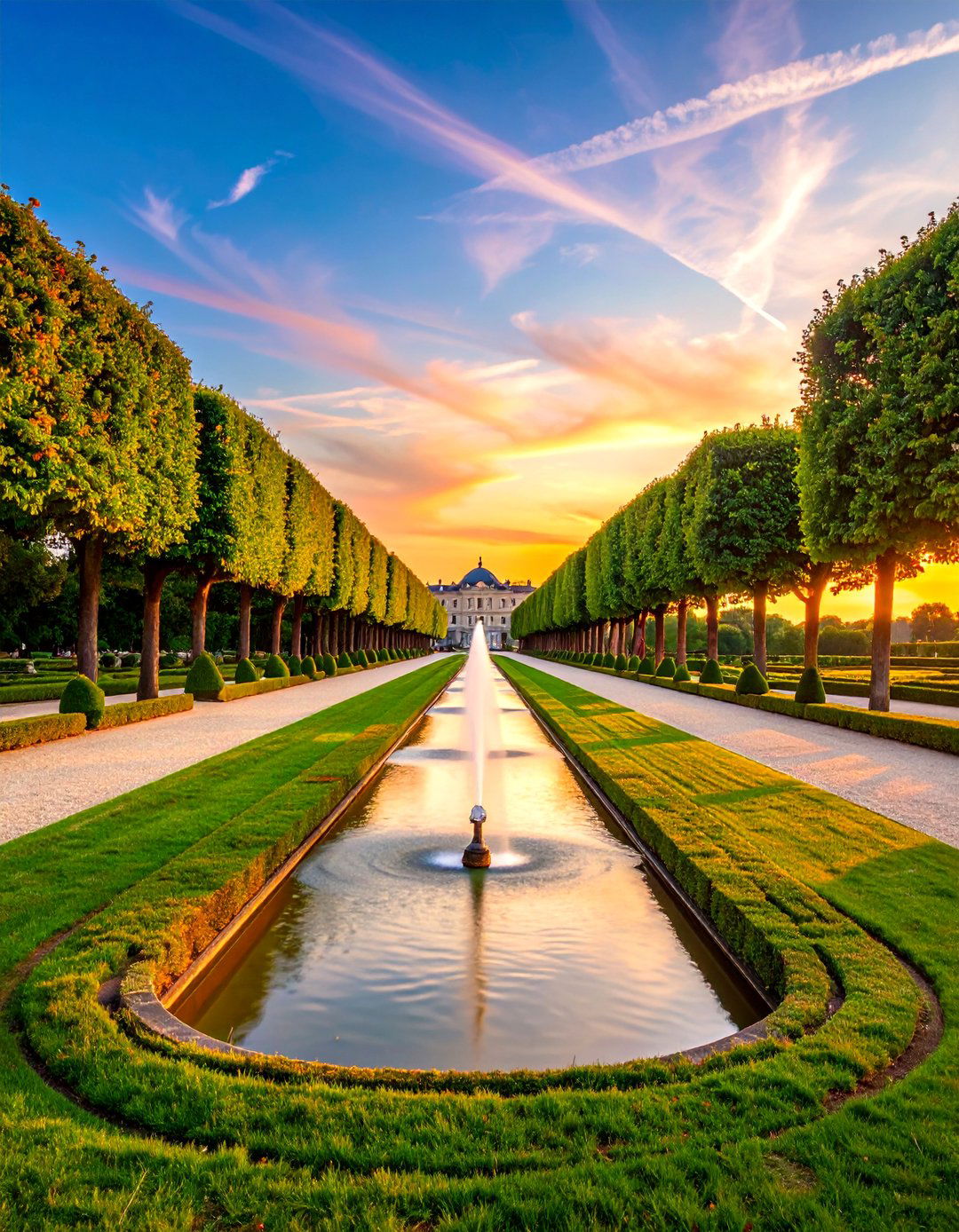
Inspired by the great palace gardens of Europe, this formal design creates sweeping tree-lined avenues that lead to and connect major garden features and architectural allées, typically planted with matching trees such as lime, hornbeam, or plane trees, create dramatic perspectives and processional routes through the the tree lines, formal plantings in geometric patterns provide seasonal interest and color, while the scale of the design accommodates large groups of visitors or ceremonial intersections feature significant architectural elements such as fountains, pavilions, or sculpture groups that serve as focal points and maintenance requirements are substantial, but the resulting garden provides unmatched grandeur and ceremonial atmosphere suitable for significant properties and public spaces.
22. Formal Water Garden with Reflecting Pools

This sophisticated garden design uses water as the primary organizing element, featuring geometric pools that reflect sky, architecture, and surrounding pools are typically constructed with stone or concrete edges that create clean, precise lines, while their proportions relate harmoniously to adjacent garden elements and around the water features emphasize form and reflection qualities, with evergreen specimens providing year-round structure and seasonal flowers adding color or water jets can be incorporated for movement and sound, while underwater lighting extends the garden's beauty into evening reflective qualities of the water double the visual impact of surrounding elements, creating a garden that changes throughout the day as light conditions design approach works particularly well in contemporary settings.
23. Symmetrical Perennial Garden with Seasonal Color

This formal garden design organizes perennial plantings in symmetrical arrangements that provide structured beauty throughout the growing layout typically features a central axis with matching plantings on either side, creating perfect mirror images that emphasize the formal design principle of selection focuses on species with strong architectural form, interesting foliage, and succession of bloom times that ensure continuous seasonal gradations from low border plants to tall background specimens create layered compositions, while repetition of key plant varieties throughout the design provides visual unity. Pathways, edging materials, and focal points such as sundials or sculptures reinforce the formal structure, while the changing nature of perennial gardens provides constant interest within the established framework.
24. Formal Entrance Garden with Paired Plantings
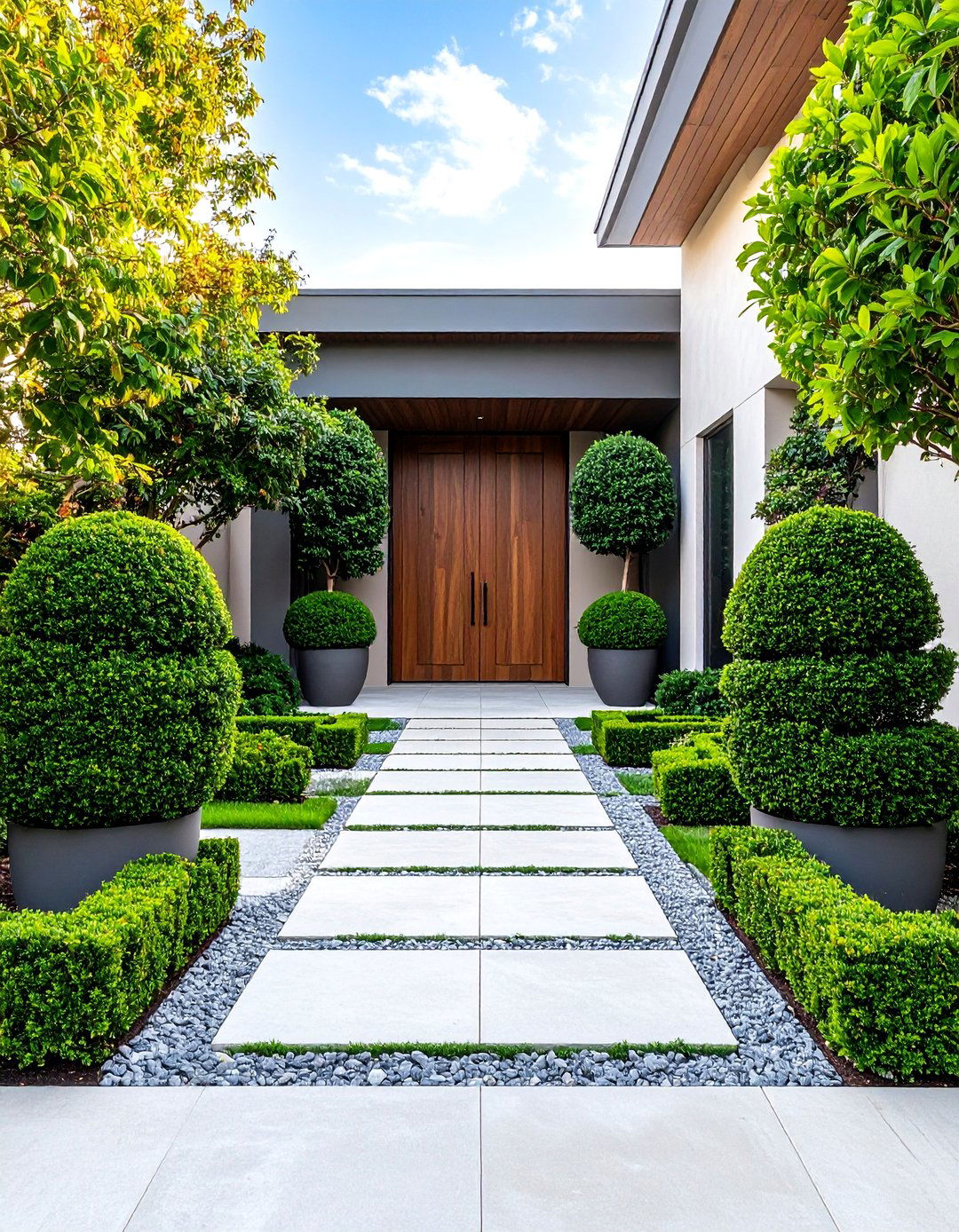
This garden design creates an impressive approach to buildings through symmetrical plantings that frame walkways and architectural specimens such as topiary, specimen trees, or large containers are positioned on either side of paths, doorways, or gates, creating formal processions that guide visitors toward design typically includes geometric planting beds that complement the architectural style of associated buildings, while materials such as stone, brick, or decorative paving create attractive transitions between garden and plantings provide changing displays throughout the year, while evergreen structure ensures year-round elements integrated into the design extend the garden's welcoming qualities into evening hours, while the formal arrangement creates an sense of importance and ceremony appropriate for significant entrances.
25. Classical Sculpture Garden with Evergreen Backdrop
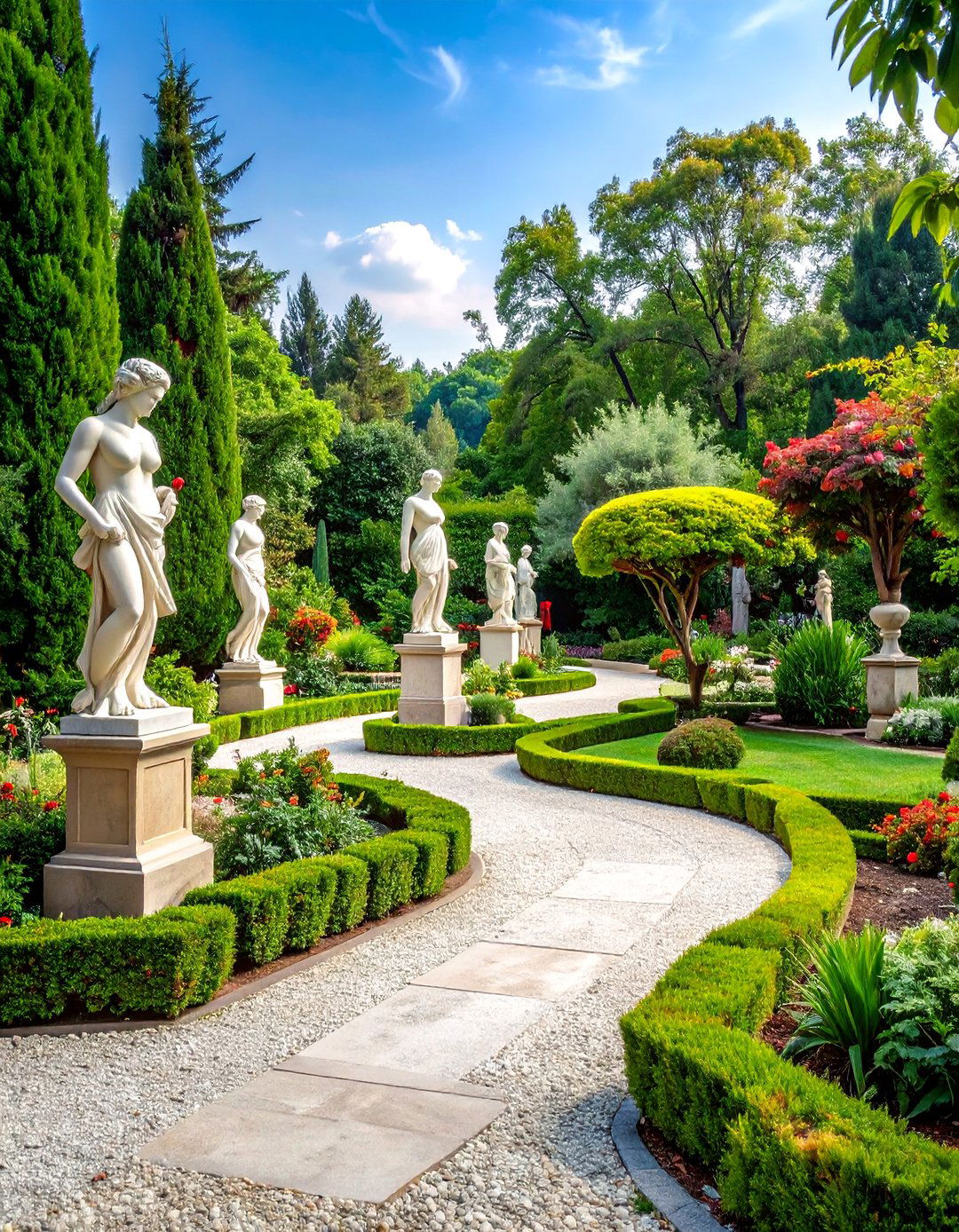
This refined formal garden design showcases sculptural art within a landscape framework that enhances both the artwork and the garden placement of sculptures creates focal points along formal axes and sight lines, while evergreen plantings provide neutral backdrops that highlight the sculptural forms without competing for garden layout typically includes geometric pathways that connect viewing points, allowing visitors to appreciate the sculptures from multiple such as gravel, stone, or grass pathways complement the formal atmosphere while providing practical circulation plantings can be included for added interest, but are carefully chosen to enhance rather than distract from the sculptural garden style creates outdoor galleries that celebrate both horticultural and artistic achievements within a unified design concept.
Conclusion:
Formal garden design offers endless possibilities for creating structured, elegant outdoor spaces that blend architectural principles with natural classical French parterre gardens to contemporary minimalist landscapes, each approach demonstrates how geometric layouts, symmetrical plantings, and carefully chosen materials can transform outdoor spaces into sophisticated extensions of refined incorporating historical elements or embracing modern aesthetics, successful formal gardens require careful planning, quality materials, and ongoing maintenance to achieve their full twenty-five formal garden ideas provide inspiration for creating distinguished landscapes that honor both traditional design principles and contemporary lifestyle needs, ensuring timeless appeal and enduring beauty.



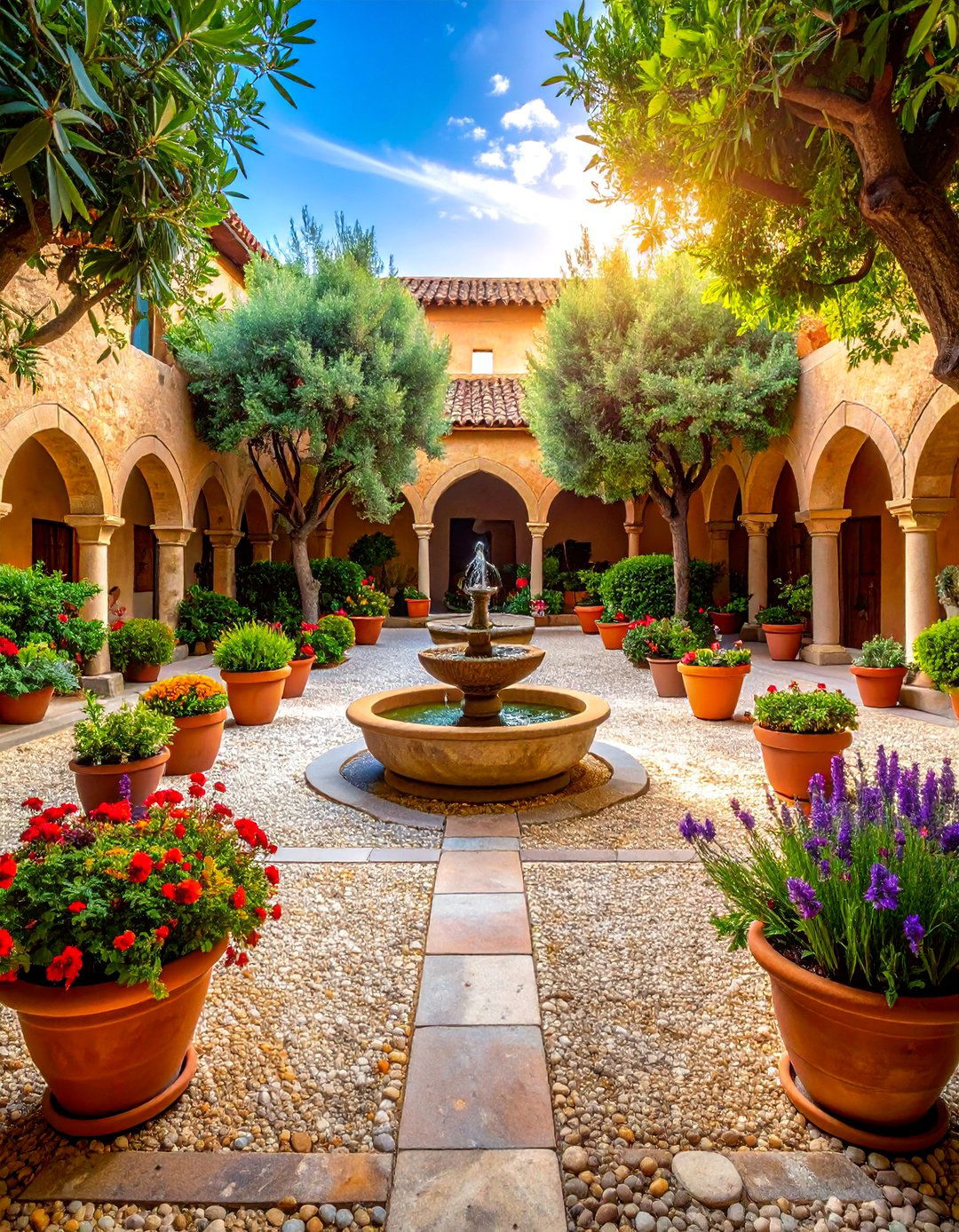








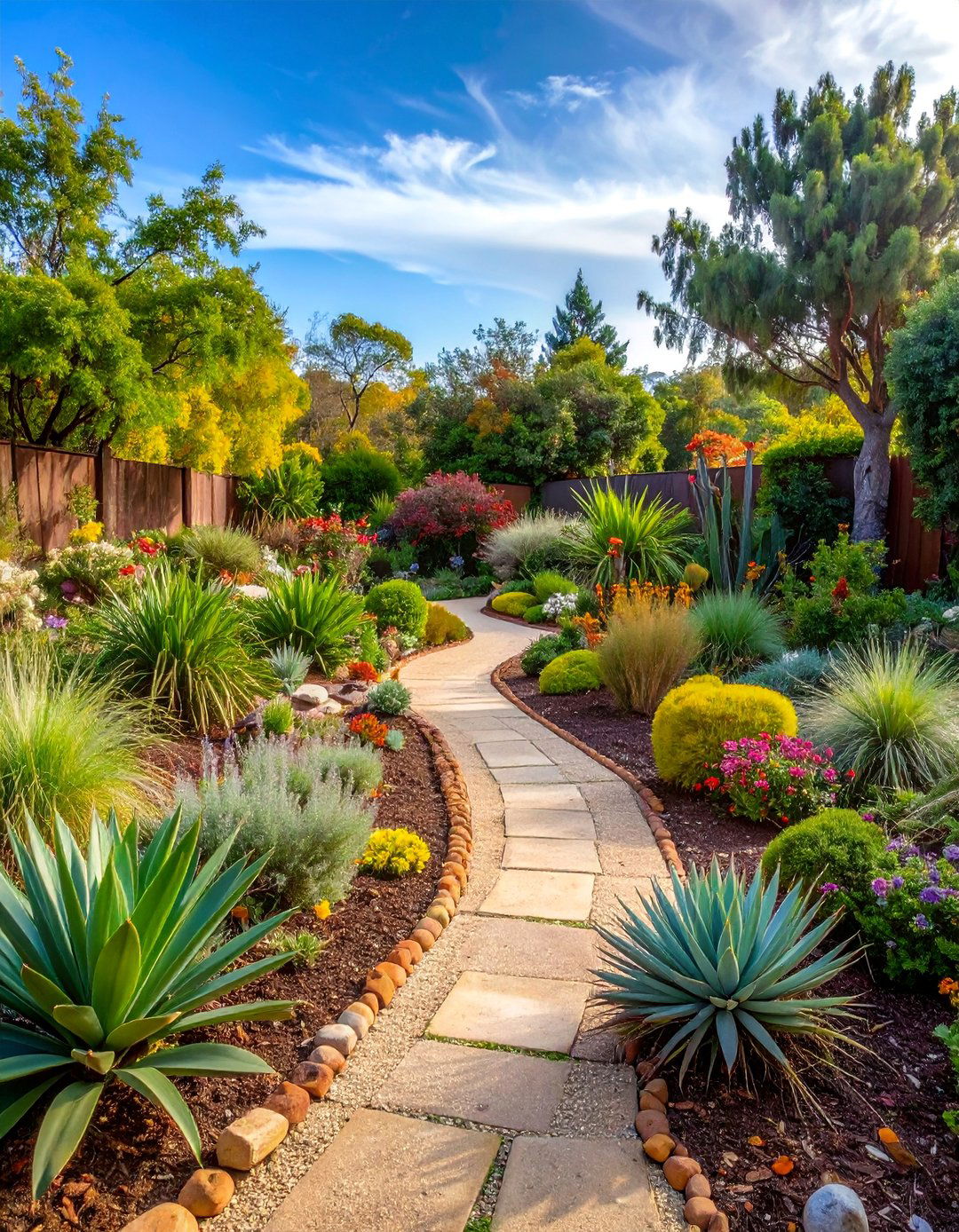

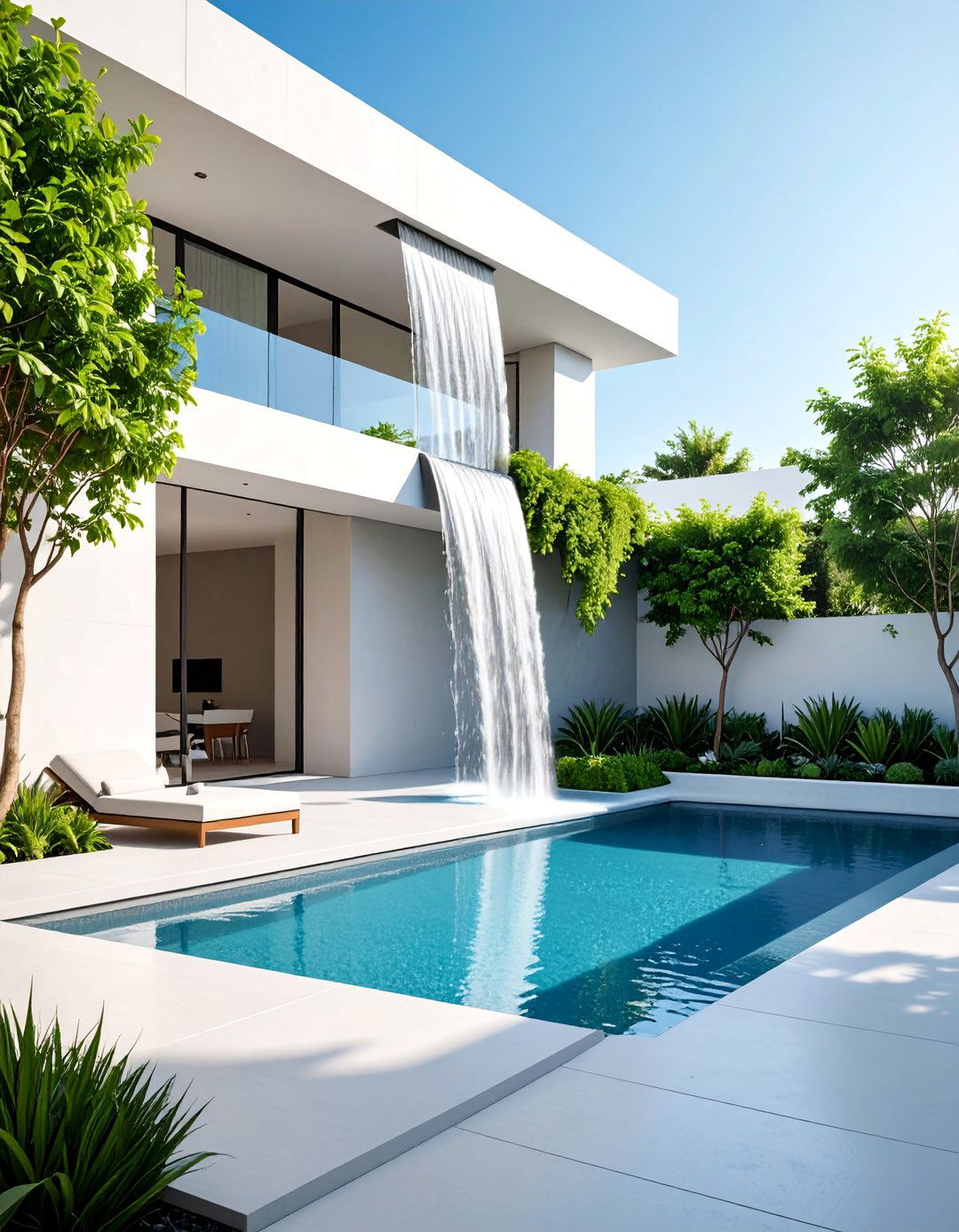
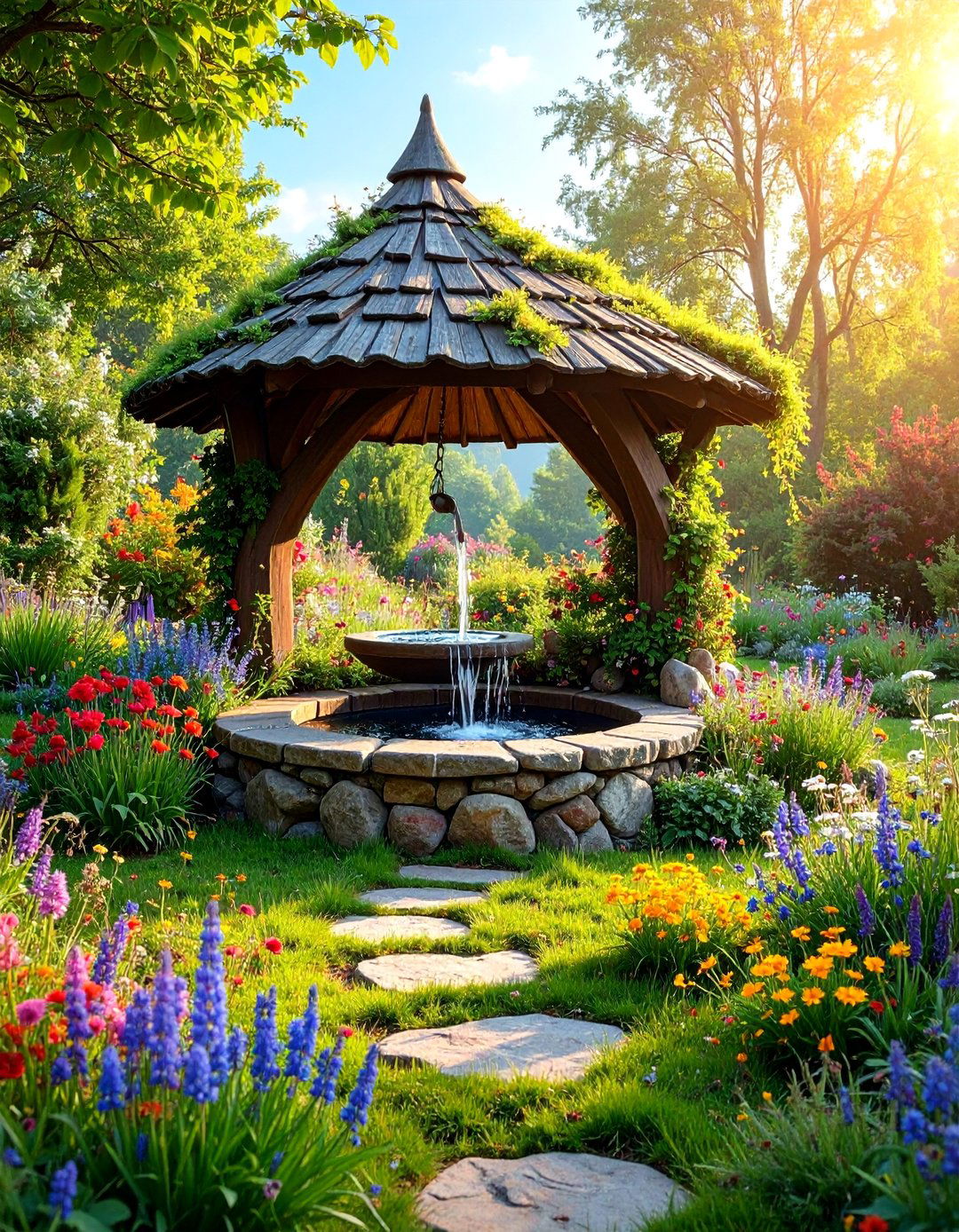

Leave a Reply